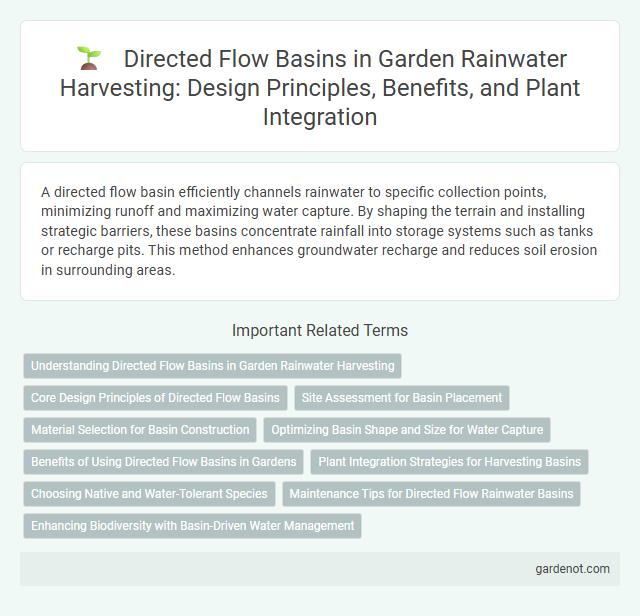A directed flow basin efficiently channels rainwater to specific collection points, minimizing runoff and maximizing water capture. By shaping the terrain and installing strategic barriers, these basins concentrate rainfall into storage systems such as tanks or recharge pits. This method enhances groundwater recharge and reduces soil erosion in surrounding areas.
Understanding Directed Flow Basins in Garden Rainwater Harvesting
Directed flow basins in garden rainwater harvesting channel runoff to specific collection points, optimizing water capture and minimizing soil erosion. These basins are designed with gentle slopes that guide rainwater efficiently toward storage tanks or infiltration areas. Properly constructed directed flow basins enhance groundwater recharge and support sustainable garden irrigation by controlling surface water movement.
Core Design Principles of Directed Flow Basins
Directed flow basins are designed to efficiently channel rainwater towards specific collection points, minimizing surface runoff and erosion. Core design principles include proper grading to ensure consistent slope, impermeable or semi-permeable surfaces to control infiltration rates, and strategically placed flow diversions to maximize water capture. Incorporating vegetation buffers and sediment traps further enhances water quality and basin sustainability in rainwater harvesting systems.
Site Assessment for Basin Placement
Site assessment for directed flow basin placement involves analyzing topography, soil permeability, and existing water flow patterns to maximize rainwater capture efficiency. Identifying natural contours and drainage paths ensures optimal basin positioning, reducing erosion and enhancing groundwater recharge. Proper evaluation of land slope and vegetation cover further supports sustainable and effective rainwater harvesting system design.
Material Selection for Basin Construction
Selecting appropriate materials for constructing directed flow basins in rainwater harvesting is crucial to ensure durability, impermeability, and environmental safety. Common materials include reinforced concrete for structural strength, HDPE geomembranes for waterproofing, and compacted clay layers to minimize seepage. Material choice depends on local availability, cost efficiency, and the basin's intended size and load-bearing requirements.
Optimizing Basin Shape and Size for Water Capture
Optimizing basin shape and size directly influences the efficiency of rainwater harvesting by maximizing catchment area and minimizing runoff losses. Designing basins with gradual slopes and concave contours enhances water retention and reduces sediment accumulation. Properly sized basins aligned with local rainfall data ensure effective storage capacity, supporting sustainable water management.
Benefits of Using Directed Flow Basins in Gardens
Directed flow basins in gardens effectively channel rainwater to targeted planting areas, promoting optimal soil moisture retention and reducing erosion. These basins increase water infiltration, supporting healthier plant growth and lowering irrigation needs. By capturing and managing runoff, they contribute to sustainable water use and enhance garden resilience during dry periods.
Plant Integration Strategies for Harvesting Basins
Directed flow basins in rainwater harvesting utilize plant integration strategies to enhance water retention and soil stabilization, promoting effective infiltration. Native drought-resistant vegetation is strategically planted to maximize water absorption and reduce surface runoff, improving basin efficiency. Root systems of selected plants aid in filtering pollutants and maintaining basin structure, supporting sustainable water management.
Choosing Native and Water-Tolerant Species
Selecting native and water-tolerant plant species for directed flow basins enhances rainwater harvesting efficiency by promoting soil stability and reducing erosion. These plants improve infiltration rates and water retention, optimizing basin performance during rainfall events. Incorporating species adapted to local conditions minimizes maintenance while supporting biodiversity and ecosystem health.
Maintenance Tips for Directed Flow Rainwater Basins
Regular inspection of directed flow rainwater basins prevents sediment buildup that can obstruct water channels and reduce collection efficiency. Clearing debris from inlets, channels, and outlet points ensures smooth water flow and minimizes the risk of basin overflow or damage. Implementing scheduled maintenance with appropriate tools, such as brushes and suction pumps, preserves basin integrity and optimizes long-term rainwater harvesting performance.
Enhancing Biodiversity with Basin-Driven Water Management
Directed flow basins in rainwater harvesting systems optimize water distribution by channeling collected runoff to targeted zones, creating microhabitats that support diverse flora and fauna. These engineered basins improve soil moisture retention and encourage native vegetation growth, fostering ecosystems that enhance local biodiversity. Implementing basin-driven water management promotes sustainable environmental balance by integrating hydrological design with ecological restoration.
Directed flow basin Infographic

 gardenot.com
gardenot.com